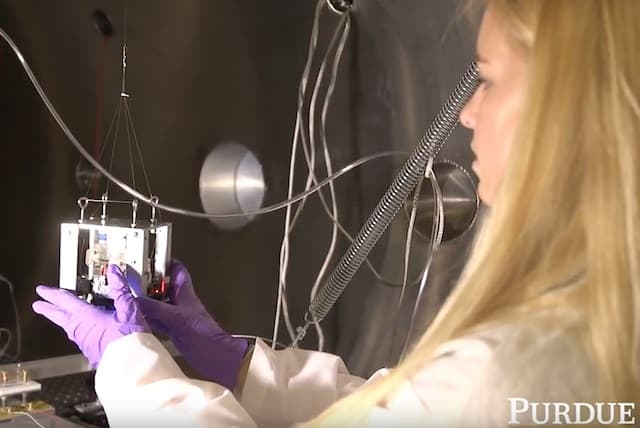Water-propelled CubeSat developed by Purdue University
A CubeSat is a miniaturized satellite used for space research that measures 10cmx10cmx10cm and weights just about 1.3 Kg. Researchers at the Purdue University have developed a new kind of propulsion system for CubeSats that makes use of bursts of water vapour to propel the satellite. CubeSats are typically low cost and are launched in bulk to perform variety of specific tasks in space. These tasks include, but not limited to, capturing high-res photos, providing Internet services, aid in disaster management, environmental monitoring and by military for specific operations.
CubeSats can achieve their full potential with the help of micropropulsion devices that offer impulse bits. Prof. Alina Alexeenko of Purdue University's School of Aeronautics and Astronautics is the lead researcher for the micropropulsion system that makes use of water. She said that water is thought to be abundant on Martian moon Phobos and it can be used as a 'gas station' in space. Water is a clean propellent which prevents contamination of on-board electronic instruments.
The new propulsion system is called 'Film-Evaporation MEMS Tunable Array' aka FEMTA thruster. It makes use of small capillaries to harness the microscopic properties of water. These capillaries are typically 10 micrometers in diameter. The surface tension of the fluid prevents it from flowing out even in vacuum of the outer space.
Tiny heaters situated towards the end of the capillaries turns water into vapour which offers the required thrust to the satellite. By activating and deactivating the heaters, the capillaries can be used as 'valves' - a technology used by regularly used inkjet printers. A research paper was published by graduate student Katherine Fowee and a team of undergraduate students. Prof. Alexeenko said that it's unusual for the undergraduate students to play a prominent role in such an advance research project.

The FEMTA thruster technology demonstrated thrust-to-power ratio of 230 micronewtons / watt for the impulses that lasted for about 80 seconds. The technology was tested in Purdue University's High Vacuum Facility's large vacuum chamber. The researchers have used a total of four thrusters to provide rotation on a single axis. The real-world satellite would require about 12 thrusters to handle 3-axis rotation.
More information about the research is available on the source link below.
Source: <a href="https://www.purdue.edu/newsroom/releases/2017/Q3/new-cubesat-propulsion-system-uses-water-as-propellant.html" target="_blank" rel="noopener noreferrer">www.purdue.edu</a>
CubeSats can achieve their full potential with the help of micropropulsion devices that offer impulse bits. Prof. Alina Alexeenko of Purdue University's School of Aeronautics and Astronautics is the lead researcher for the micropropulsion system that makes use of water. She said that water is thought to be abundant on Martian moon Phobos and it can be used as a 'gas station' in space. Water is a clean propellent which prevents contamination of on-board electronic instruments.
Tiny heaters situated towards the end of the capillaries turns water into vapour which offers the required thrust to the satellite. By activating and deactivating the heaters, the capillaries can be used as 'valves' - a technology used by regularly used inkjet printers. A research paper was published by graduate student Katherine Fowee and a team of undergraduate students. Prof. Alexeenko said that it's unusual for the undergraduate students to play a prominent role in such an advance research project.

The FEMTA thruster technology demonstrated thrust-to-power ratio of 230 micronewtons / watt for the impulses that lasted for about 80 seconds. The technology was tested in Purdue University's High Vacuum Facility's large vacuum chamber. The researchers have used a total of four thrusters to provide rotation on a single axis. The real-world satellite would require about 12 thrusters to handle 3-axis rotation.
More information about the research is available on the source link below.
Source: <a href="https://www.purdue.edu/newsroom/releases/2017/Q3/new-cubesat-propulsion-system-uses-water-as-propellant.html" target="_blank" rel="noopener noreferrer">www.purdue.edu</a>
0
